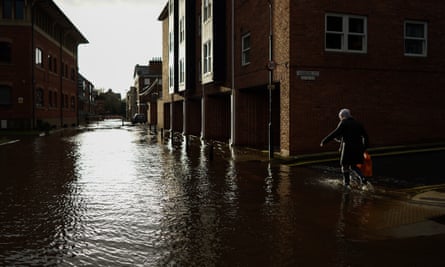It was like a cloudburst. The downpour came so quickly and with such ferocity that some residents of Walthamstow in north-east London didn’t have time to salvage their belongings from the flood as a month’s worth of rain came down in just a few hours.
“I’ve lost weight, lost hair and haven’t been eating,” says one homeowner whose house ended up under a foot of water that poured in from the street and the back garden.
Their experience at the end of July was mirrored in areas across London and in parts of Suffolk and the Isle of Wight, while in Europe record-breaking rainfall this summer has led to catastrophic destruction.
This has been attributed to the climate crisis and scientists have warned of more to come as temperatures rise. Without action to protect homes from increases in this kind of extreme weather, householders can expect to see the consequences in their insurance bills.
The UK’s biggest insurer, Aviva, estimates that one in five properties in the UK are at risk of surface-water, river or coastal flooding. It says there has been a “major spike” in claims in the past two years. “Even more worryingly, as seen in July, there appears to be a rise in the number of flood events outside of winter months, due to increased surface water following heavy downpours,” it says.
Camilla Yates from price comparison website MoneySuperMarket, says insurers will inevitably increase prices, with homes in flood-risk areas likely to see the biggest rises.
“Providers are constantly monitoring risks and adjusting prices in line with the cover they provide, which means that for every year in which we see more flooding, there is the potential for prices to go up,” she says.
In 2020, the cost of the average premium for buildings and contents cover was £314, similar to the year before, according to the Association of British Insurers. What will now follow is unclear, but the scale of damage flooding can inflict is substantial. Last year, the ABI said the average household flood claim was £32,000.
 View image in fullscreenFlooding in York in January, in the wake of Storm Christoph. Photograph: Ian Forsyth/Getty Images
View image in fullscreenFlooding in York in January, in the wake of Storm Christoph. Photograph: Ian Forsyth/Getty Images
However, it is not just money that is at stake, says Paul Cobbing of the National Flood Forum, a charity offering help to affected people. “Ultimately, flooding is a people thing, not an environmental, financial, economic or technical thing,” he says. “Lives can be utterly transformed. Flood incidents can be life-changing and it is these aspects that are the least supported.”
There are some measures you can take to avoid such an experience:
Check the Environment Agency’s website. This tells you whether your property is at immediate risk, will be at risk within five days, or is in an area that is likely to flood in future. The agency can also prepare a report on the flooding history of a property – useful if you are planning to move and want to do some research in advance, as well as if you have concerns about your existing home. If it takes less than 18 hours to prepare, it is free. But if it takes longer, it will cost at least £450. You will then be offered the chance to decide if you want go ahead.
Make sure that your insurance policy includes cover for flooding. Contact the British Insurance Brokers’ Association if you want to find someone to help you source better cover. If your property was built before 2009 and is in an area at risk of flooding, it may qualify for cover under Flood Re, the government scheme that offers subsidised insurance to especially vulnerable buildings. It operates via insurers and charges a fixed fee based on council tax bands for buildings and contents insurance.
If you are buying a newly built home, ask the builder if it has included any flood mitigation measures. These can include installing water-resistant external doors and windows, sealing external walls – or “tanking” – to make them waterproof, re-pointing brickwork to reduce penetration of water, or raising the threshold of a porch in order to make it more difficult for water to get in. If there are no flood mitigation measures, consider putting them in yourself.
If you are a renter, ask your landlord what standard of flood cover the property has. And check whether you will be able to get cover for alternative accommodation if you have to move out as a result of a flood.
Seek advice if your insurer turns down the claim. One Walthamstow resident whose home was affected had her claim refused by insurer MoreThan, which said that the weather was not severe enough to be classed as a storm. After the issue was highlighted by local Labour MP Stella Creasy, the insurer said that it had made a mistake and “misinterpreted a weather report and therefore incorrectly declined the claim”. It then contacted the customer to settle.
If your insurer refuses to pay up, the National Flood Forum can offer advice. “People can come across lots of different issues, ranging from problems with the insurance company to people taking out the wrong insurance, or with not enough cover,” says Cobbing. “The detail is important: read the policy in detail when you take out cover. But also, some insurance companies are not so good at paying claims.”
Look for a Flood Action Group (FAG), which can be created by neighbours to reduce the risk of floods in their area. They typically liaise with agencies and councils to tackle risks.
“Responsibilities for managing flood risk are complex, and FAGs can be really useful in making things happen to reduce risk,” says Cobbing.
If you discover there is a risk in your area, gather evidence and make sure local councillors as well as council planners know about it, so that it can be taken into account when planning decisions are made in the future.
Practical prevention
There are a number of simple steps you can take to limit the effects of a flood on your home and property:
Airbrick covers limit the risk of water coming in through airbricks, costing from £12 for the cheapest version.
Demountable flood barriers can be erected in doorways when flooding is expected. Prices vary widely, with online versions starting at just over £260 while some specialist companies charge over £400.
Non-return valves (NRVs) can be fitted to drains in order to stop sewage or floodwater backing up into the property, starting at about £35.
Silicon sealing. Water can enter homes through the gaps around wires and pipes – gaps that can be sealed with silicon.




